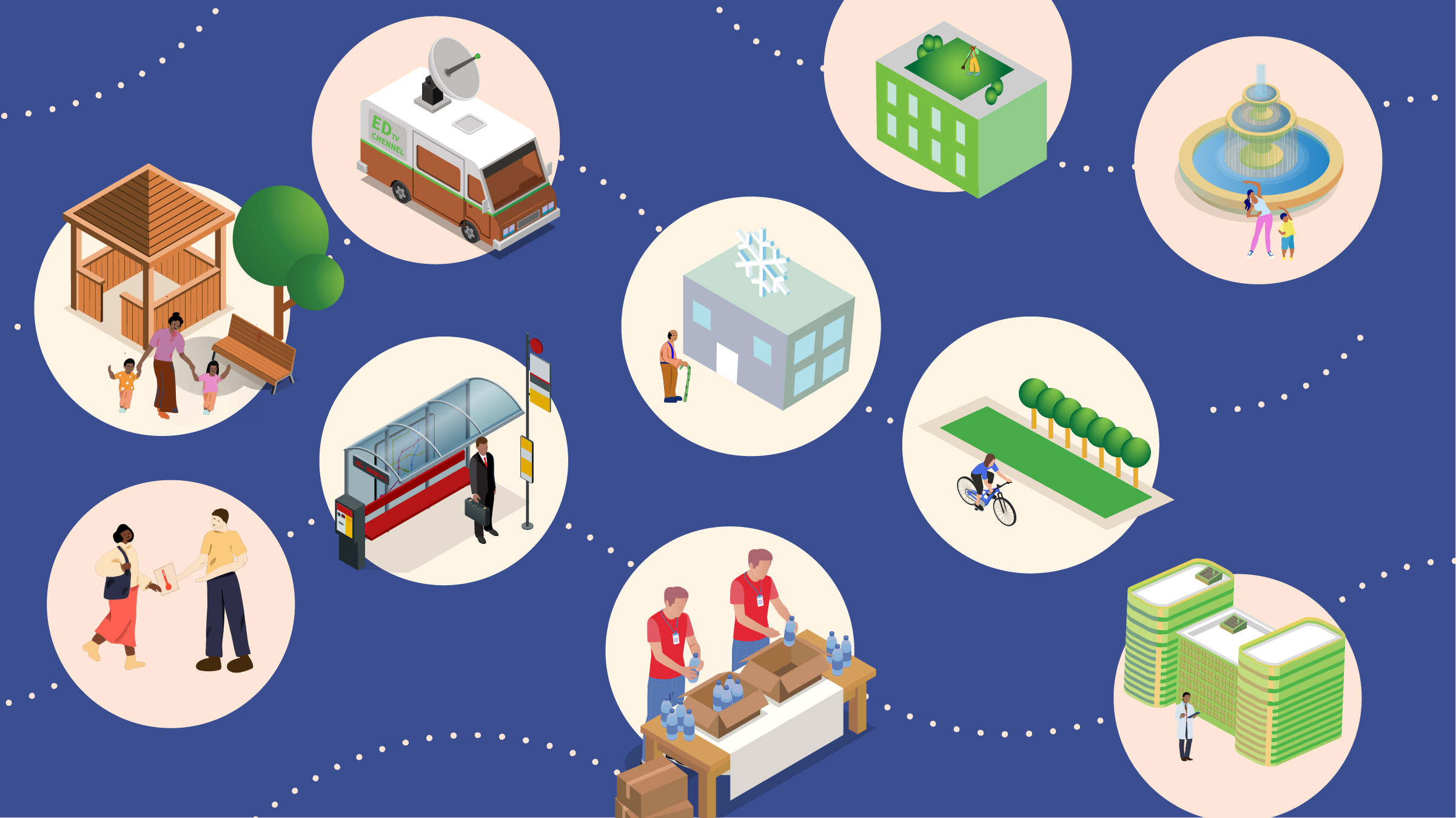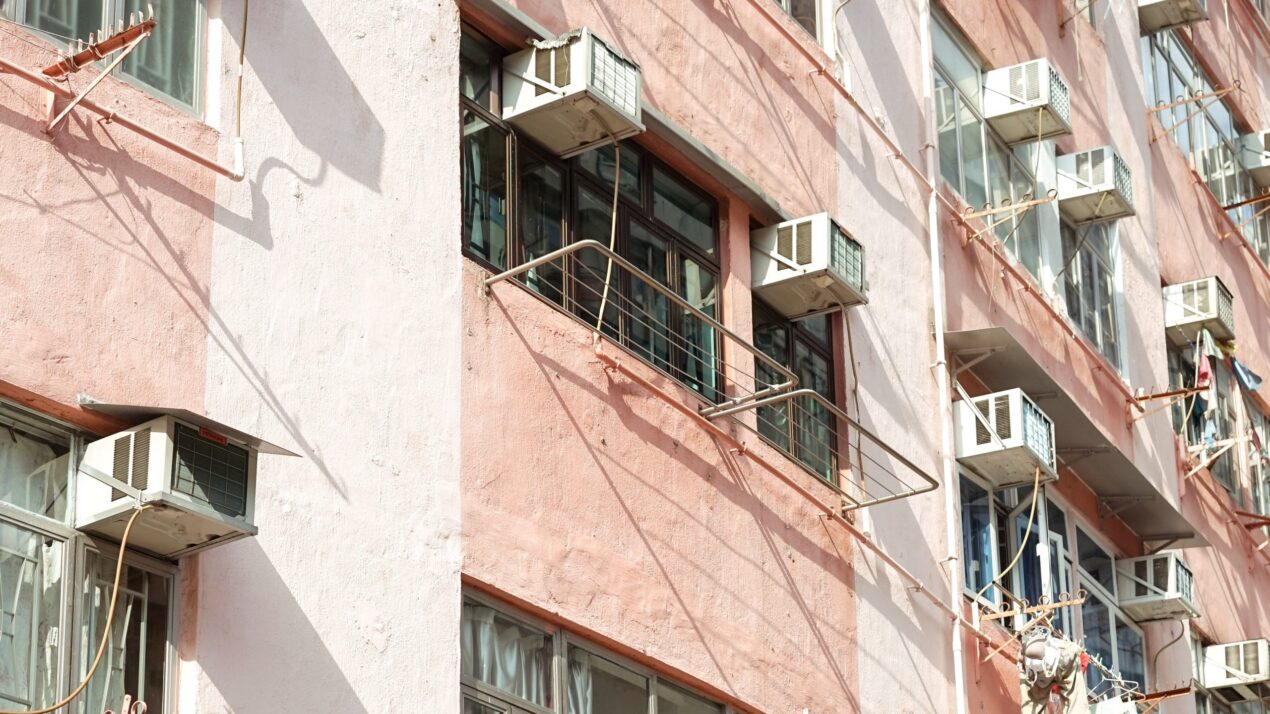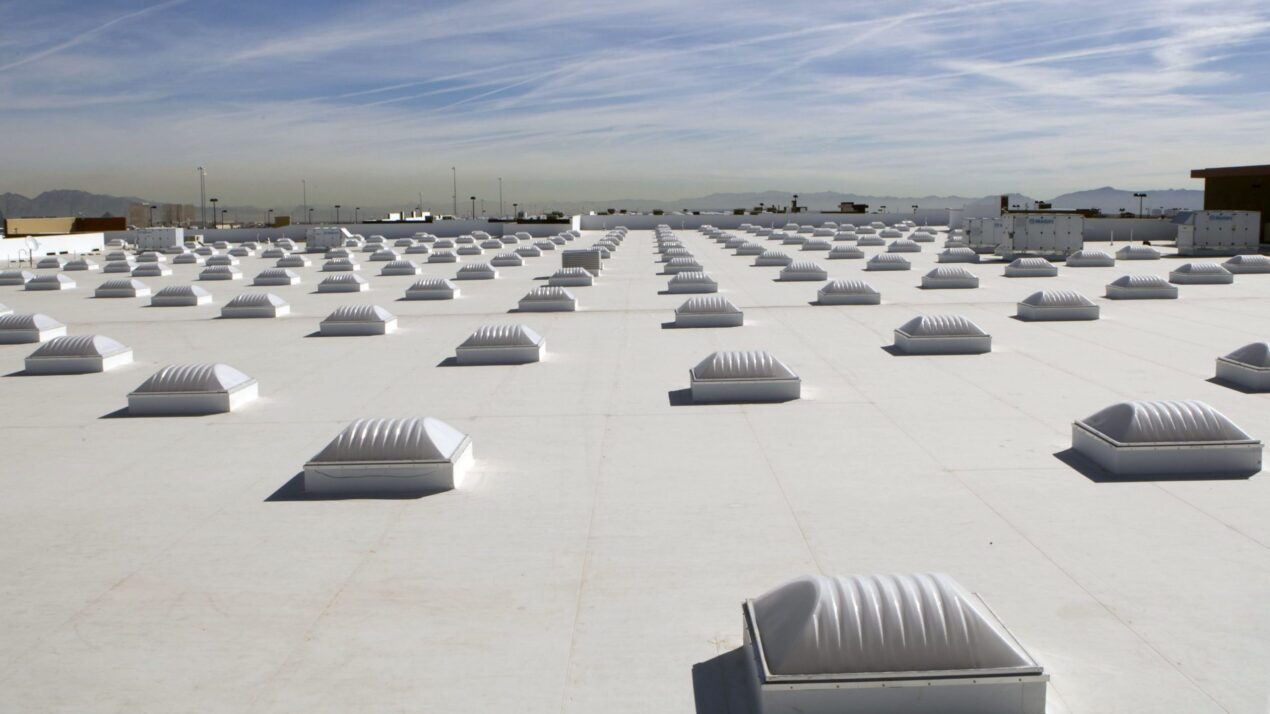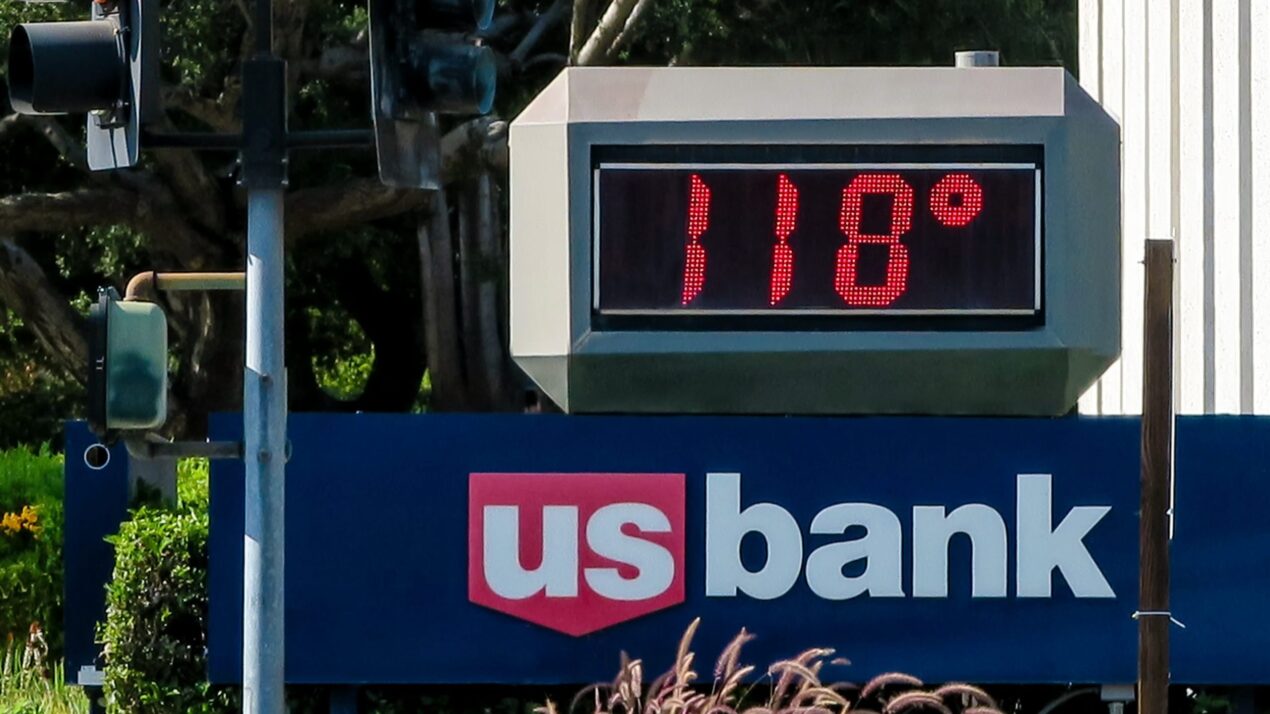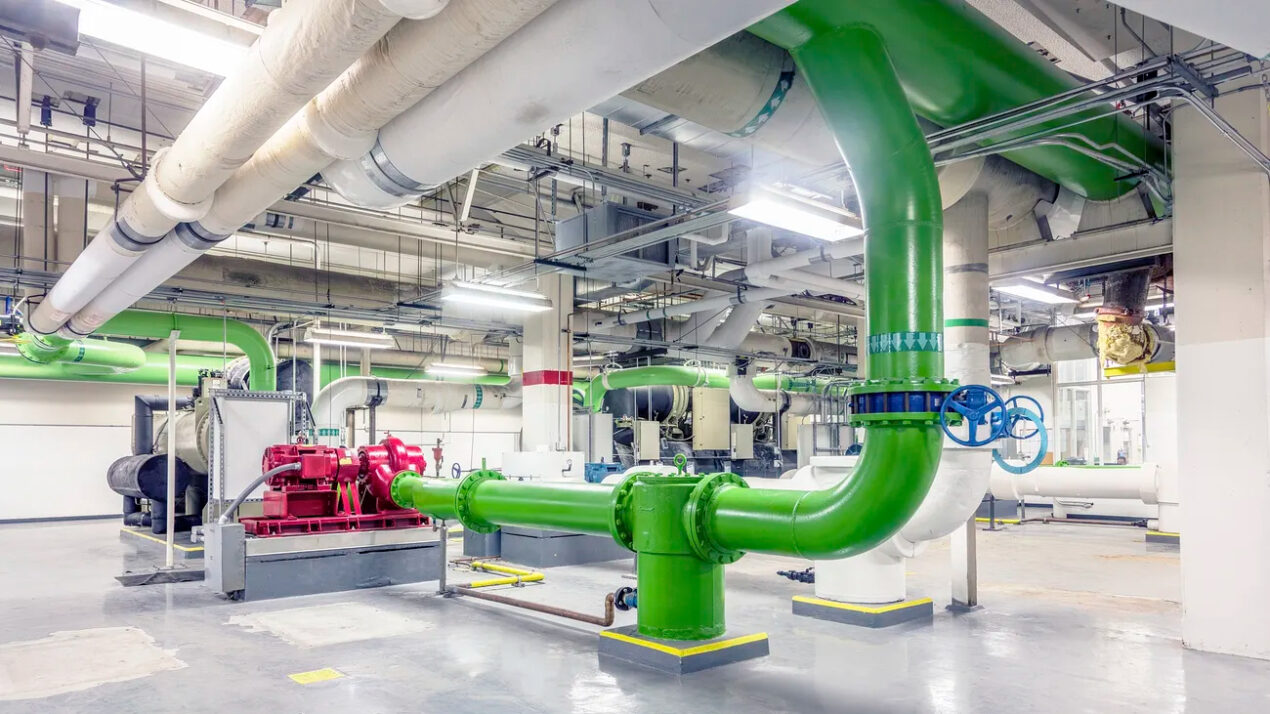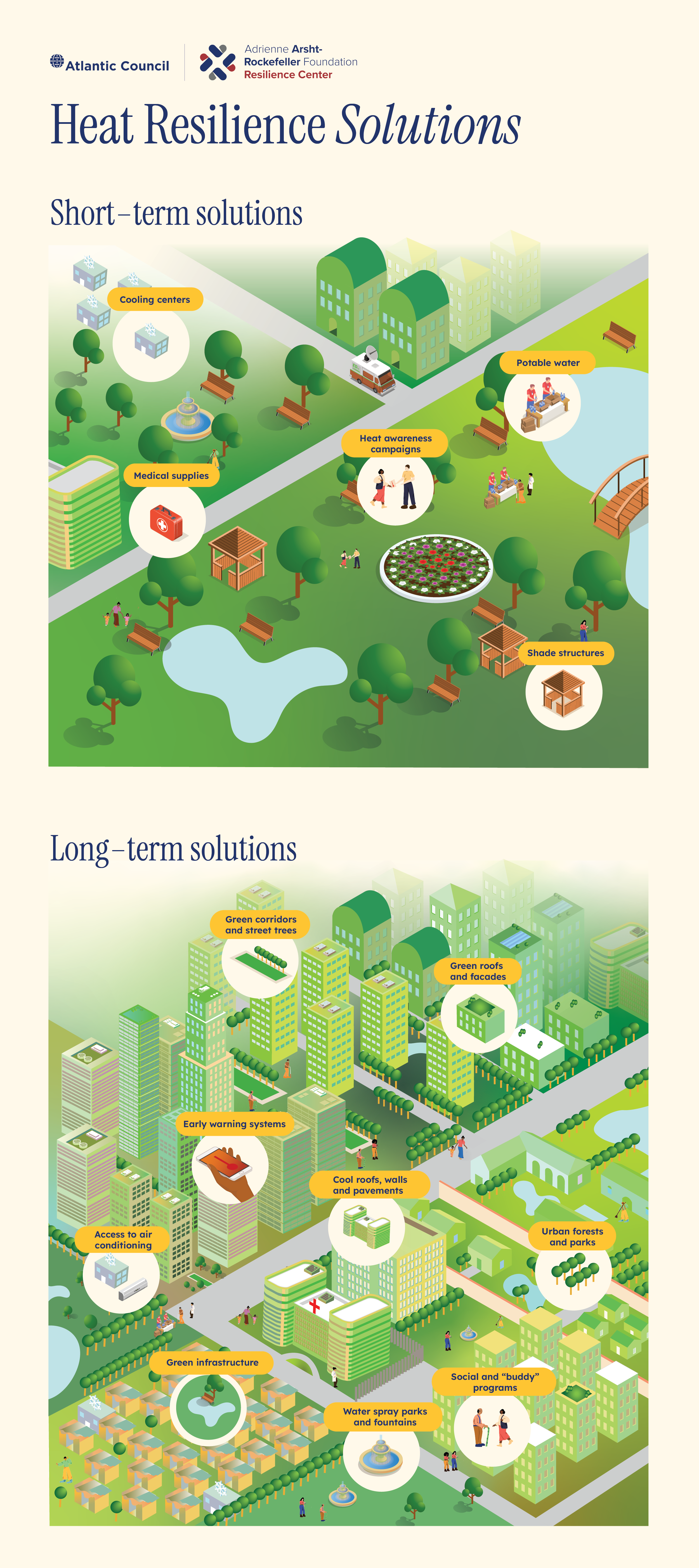Objective
Welcome to the Explore Heat Adaptation Solutions module! Heat resilience solutions can offer many health, economic, educational, and infrastructure-related benefits. Co-benefits can include improving air quality, reducing energy use and lowering greenhouse gas emissions. However, the array of cooling, educational, and health protection strategies and technologies available can be overwhelming.
This module will help you identify effective solutions for your local context. During this step, you will identify the partners and resources required for successful design, implementation, and monitoring. Selected interventions should directly address the vulnerabilities and impacts identified in the Assess phase.
Essential Actions, Outputs, and Outcomes from this Module
Actions
-
Discuss what heat resilience solutions are appropriate for your jurisdiction with key community leaders, civil society organizations, local officials, and subject matter experts.
-
Identify the financial mechanisms, policies and environmental conditions that might present limitations to and opportunities for implementing specific solutions.
-
Select the appropriate set of solutions from options such as urban greening, cool roofs, early warning systems and social programs.
Outputs
-
Analysis of current policies and programs and their effect on heat resilience.
-
List of appropriate solutions based on discussion with stakeholders.
-
List of limitations and opportunities for implementation of solutions.
Outcomes
-
Identify heat resilience solutions that are applicable to your context and opportunities to take action.
-
Understand the enabling conditions that will support the successful implementation of policies and interventions.
-
Understand the barriers to adopting and implementing policies and action-oriented solutions.
-
Partner with communities to co-develop solutions.
-
Understand what technical skills and capacity are required to design, implement, and monitor solutions.
Overview
The Essential Actions, Outputs, and Outcomes include the core elements of the more comprehensive approach described throughout the rest of the module. We know that time, resources, and capacity can limit the breadth and depth of interventions you undertake. Simply beginning to explore these modules and consider what solutions are appropriate for your context is a critical step toward building your jurisdiction’s heat resilience. At any point, reach out to Arsht-Rock using the contact form at the bottom of the page with questions and comments.
Identifying solutions
Discuss what heat resilience solutions are appropriate in your context with community leaders, subject matter experts, and the other stakeholders you have engaged up to this point. Prioritize taking an integrated, multi-solution approach rather than deploying a single solution. The right solutions for your area will vary based on local context, such as which hazards cause the greatest harms. However, using a combination of different approaches that can be implemented at scale will make a greater impact than investing in one approach due to their mutually reinforcing effects. The combined benefits will be greater than the individual parts.
More broadly, a flexible adaptation plan involving a sequence of strategies that together build resilience and reduce risk is the best approach for dealing with the dangers of extreme heat. Many existing policies, plans, and regulations will impact your goals to build heat resilience. For example, city initiatives to protect biodiversity or increase access to green space may pose opportunities to integrate a heat health lens and consider whether these initiatives target hotter areas in the city. Developing energy-efficient buildings not only protects people from extreme heat, but can reduce communities’ economic and energy challenges. When identifying specific solutions and technologies, consider what other challenges your community faces and how heat policies can address them.
Some solutions can have lengthy implementation timeframes and high costs and may not be feasible. Work with these stakeholders and review existing research to identify what interventions are most appropriate for your climate and geography (see Conduct a Baseline Heat Risk Assessment) as well as potential implementation timeframes and funding sources.
Resources
Heat Resilient Cities Benefits Tool
- Global
For a tool to help you quantify the health, economic, and environmental benefits of heat adaptation solutions for your city, see the Heat Resilient Cities benefits tool produced by C40 and Ramboll.
Beating the Heat
- Global
For information on the ease of implementation, barriers, and the impacts of cooling solutions in cities, see pages 34-38 and 56-57 in the Beating the Heat handbook developed by the Cool Coalition, the UN Environment Programme, RMI, Global Covenant of Mayors for Climate & Energy, Mission Innovation and Clean Cooling Collaborative.
Planning for Urban Heat Resilience
- United States
For information on setting urban heat goals and how to develop a framework around your planning efforts, see pages 38-42 of Planning for Urban Heat Resilience from the American Planning Association.
Overcoming barriers
Lack of awareness
Local authorities, civil society, and residents are often unaware of or underestimate the impact of heat, and thus might view it as unimportant or business as usual. Conducting a heat mapping analysis or vulnerability assessment, as discussed in the Assess phase, will quantify and bring to the fore the health and economic impacts of heat. Stakeholder engagement as a part of these assessments or as a part of a heat communications campaign can also build understanding and momentum around the issue.
Lack of access to funding and financing
Though heat adaptation and preparedness measures range from low/no-cost to major redevelopment and infrastructure projects, it can be difficult to identify government budget, philanthropic sources or other flows of capital for these projects. When making the case for a project, consider analyzing and raising awareness of both the existing costs of heat (e.g., strain on critical infrastructure like health and energy, reduced labor productivity) as well as the potential cost savings from the project (e.g., reduced energy bills) that in combination could offset the cost of investment over time.
Lack of ownership
Given heat’s cross-cutting effects on public health, infrastructure, disaster management, and other sectors, it is often left without a sole “owner” or responsible government agency. Some cities and regions have addressed this gap by creating a heat health task force that brings together stakeholders from the full spectrum of agencies, organizations, and communities that need to be at the table when preparing for heat. Others have appointed a chief heat officer to communicate heat’s impacts and coordinate agency efforts on heat-related policies and projects.
Investing in equity and environmental justice
Green gentrification may occur when the process of environmental restoration or deploying climate-adaptive infrastructure negatively impacts current residents. For example, new parks or cool corridors can result in increased property values, rent, demolishment of existing buildings, and can cause immediate or eventual displacement of current residents. These negative outcomes often disproportionately harm residents of a certain race, level of income, or social group.
When identifying the type and location of a specific heat resilience project, in addition to considering the areas of the city with the highest temperatures, least developed cooling infrastructure, and highest numbers of heat-vulnerable residents, also consider the broader impacts of the project and how it may contribute to existing dynamics of marginalization and displacement in a neighborhood.
Direct and sustained community engagement from the beginning of the planning process will be essential to avoiding maladaptive outcomes. This requires that community members to see the project as beneficial and be willing to invest their time and effort. Clearly outlining potential benefits, inviting community members to co-lead the process, and potentially compensating community members for their time can further this effort.
Resources:
Inclusive Climate Action in Practice
- Global
For case studies of cities that have centered environmental justice and citizen engagement in heat-related projects, see pages 24-37 of Inclusive Climate Action in Practice from C40
Heat Action Planning Guide
- United States
For an overview of how The Nature Conservancy and partner organizations engaged communities in three neighborhoods on heat planning via a series of community workshops, see pages 9-12 of the Heat Action Planning Guide for Neighborhoods of Greater Phoenix.
Primer for Cool Cities
For an overview of solutions or urban cooling, see Chapter 3 of Primer for Cool Cities: Reducing Excessive Urban Heat by The World Bank.
Common preparedness and adaptation solutions
Active vs. passive cooling
Active cooling refers to heat reduction mechanisms that use energy to dissipate heat, while passive cooling refers to a broad range of building materials, design choices, and natural solutions that reduce indoor air temperatures and, when deployed at scale, outdoor air temperatures. Examples of active cooling include air-conditioning, fans and district cooling, and passive cooling includes interventions such as changing the roof surface of a building so that more sunlight is reflected and less heat is absorbed into the building, or adding shading on windows or around buildings.
- Active cooling is typically adjustable, so this may be useful on extremely hot days, especially for individuals who are particularly physiologically vulnerable to heat. However, these active measures consume energy, and high energy costs may limit use for low-income populations. Additionally, many populations lack access to air-conditioners or the energy to operate them. Finally, the use of air conditioning can increase the overall heat of an area (known as “waste heat”).
- Passive cooling measures such as green infrastructure, cool roofs, or improved building design to reduce heat retention may have higher up-front construction costs than conventional materials and design measures are rarely adjustable for extraordinarily hot days. However, there is little to no energy cost associated with these measures over the long term and they can be deployed across the world, including where stable energy grids are unavailable.
Passive cooling options range from low-to-high cost and your choice of technology should reflect your local environment. For example, expanding urban forests can have a significant heat reduction impact, but in low water/drought-prone environments, building design improvements may be more appropriate. Also consider how traditional or indigenous designs and technologies from your region can be used to cool houses and neighborhoods, such as wind catchers and lattice screens.
Resources:
Beating the Heat
- Global
For information about passive cooling including a graphic and the core concepts of passive cooling principles (page 25) and descriptions of passive cooling options and pros and cons listed (Chapters 6 and 7), see the Beating the Heat handbook, developed by the Cool Coalition, the UN Environment Programme, RMI, Global Covenant of Mayors for Climate & Energy, Mission Innovation and Clean Cooling Collaborative.
Primer for Cool Cities
- Global
For an overview of urban cooling solutions, see Chapter 3 of Primer for Cool Cities: Reducing Excessive Urban Heat by The World Bank.
Green Infrastructure
Trees cool the surrounding air primarily by shading surfaces such as concrete and asphalt, preventing heat storage, as well as through evapotranspiration. These reductions in air temperature by urban trees can have significant health impacts. One modelling study of US cities found that urban tree canopy reduced mortality by around 1,200 lives annually.
Resources
Green Infrastructure Toolkit
- United States
For an overview of green infrastructure strategies as well as approaches to funding and financing projects, see the Green Infrastructure Toolkit from Georgetown Climate Center.
Green Infrastructure Design and Implementation
- United States
For design guides, tools, and implementation considerations, see the US Environmental Protection Agency’s Green Infrastructure Design and Implementation webpage.
Cool Roofs, Walls and Roads
Approximately 60 percent of urban surfaces are covered by roofs or pavements, and many of these surfaces are less reflective, resulting in greater absorption of sunlight and conversion of solar energy into heat.
Cool roofs
- Increasing the reflectivity of rooftops can reduce temperatures of buildings by 40° Fahrenheit, according to the city of Philadelphia Energy Coordination Agency. In areas where high temperatures lead to increased air-conditioner use and significant electricity demand, cool roofs can reduce peak power use and save residents money on energy bills.
- Roofs with high levels of reflectivity are not necessarily white roofs. New roofing materials exist that are strongly reflective but are red, green, or grey in color.
- Over time, cool roofs will naturally become less reflective due to collected dust, dirt, and other substances. In spite of this, aged cool roofs are still significantly more reflective than conventional roofs.
Cool pavements
- Though conventional, dark paving materials can reach extremely high temperatures, particularly in the summertime, options exist for more reflective or permeable pavements that stay cooler. The reduction in maximum temperatures may result in increased durability, and lighter pavements can increase visibility at night, resulting in safer streets.
- Permeable pavement (i.e., pervious concrete, porous asphalt, reinforced grass pavements) are naturally cooled through the evaporation of moisture.
Resources
A Practical Guide to Cool Roofs and Cool Pavements
- Global
For an introduction to cool surfaces and product selection, see A Practical Guide to Cool Roofs and Cool Pavements from the Global Cool Cities Alliance.
Cool Roofs: Protecting Local Communities and Saving Energy
- India
For examples of cool roof types applied in India, see page 10 of Cool Roofs: Protecting Local Communities and Saving Energy by the Natural Resources Defense Council, Mahila Housing Trust, and other partners.
Early warning systems
Warning systems for extreme heat that provide advance notice of high temperatures or projected health impacts, when paired with guidance for individuals on how to respond, has been shown to raise awareness and save lives.
Resource
Global
Show details
For a technical guide on developing a heat early warning system, see the World Health Organization and World Meteorological Organization’s joint publication, Heatwaves and Health: Guidance on Warning-System Development.
Social programs and interventions
Several cities have launched community-based programs and volunteer networks to reduce the likelihood of heat-related harms to people who are socially isolated, disabled, or elderly. This can include wellness checks, buddy programs, heat health hotlines, and other forms of community-based mutual support.
Resources
Be a Buddy Program
- United States
Explore the Be a Buddy program for a New York-based example of a community-led social resilience program that involved community organizations in recruiting and training local volunteers.
Better Prepared Neighbors
- Argentina
For an example of a program that involves elderly individuals in raising awareness of heat risk, see page 90 of the Buenos Aires Climate Adaptation Plan.
Block Captains
- United States
For an example of how to use neighborhood-level governance structures to strengthen community cohesion ahead of and during heat waves, read about the City of Philadelphia’s Block Captains program on page 29 of the Excessive Heat Events Guidebook from the US Environmental Protection Agency.
District cooling
District cooling systems typically use a central source (a chiller plant) and a network of underground pipes to deliver chilled water to buildings across an area. The buildings utilize the water for indoor cooling, after which the water returns to the central plant and is chilled again. These systems can offer significantly more efficient cooling for these buildings. However, given the scale of the infrastructure and density of the area needed to develop district cooling, assess whether your community has upcoming new construction and the necessary capital and technical capacity necessary to invest in this approach.
Congratulations! You’ve completed Explore Heat Adaptation Solutions.
Review the Essential Actions, Outputs, and Outcomes from this Module or proceed to the next module.

